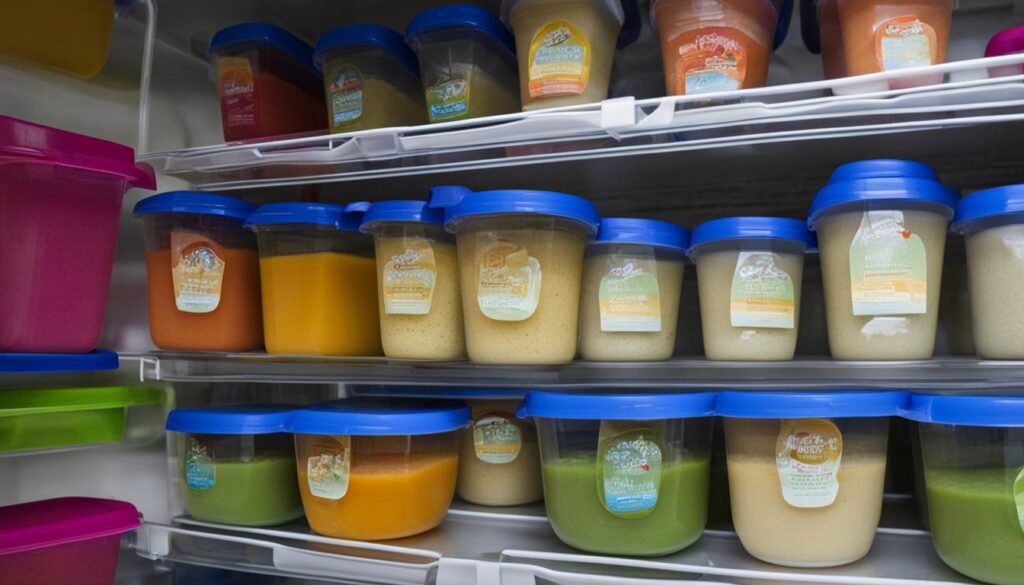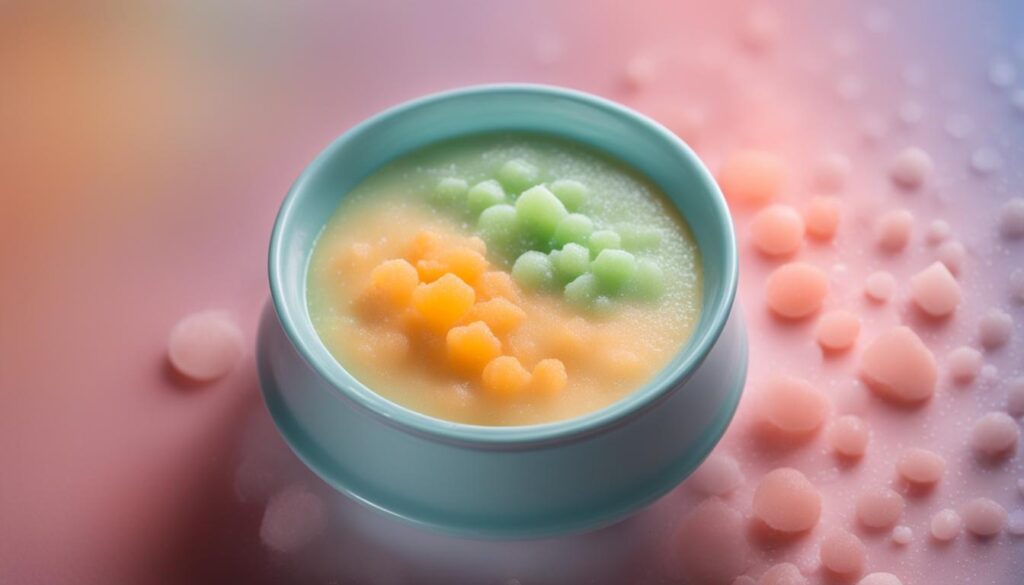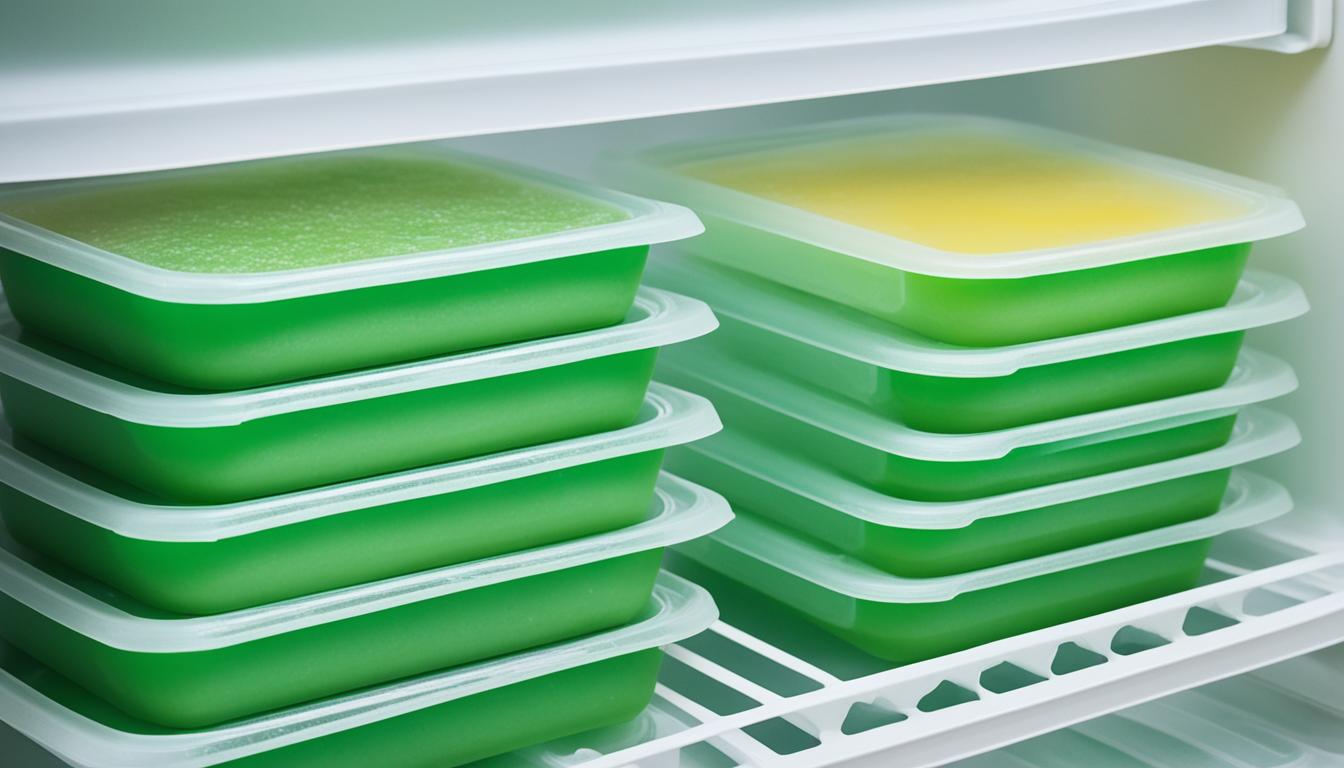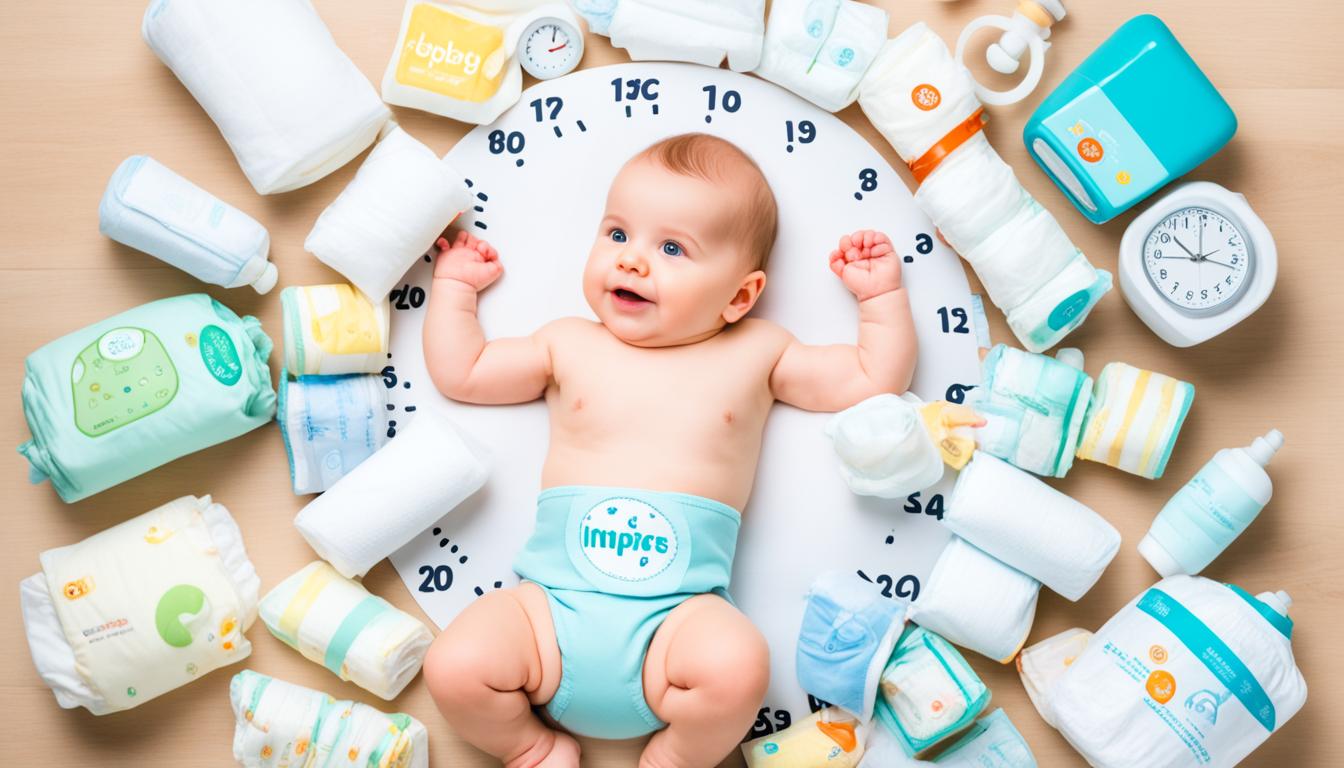Can You Freeze Baby Food? Quick Tips & Safety Guide
Yes, you can freeze baby food, an effective strategy for parents looking to store homemade meals efficiently. Whether you’re making homemade baby food or using store-bought options, proper storage is key. In this guide, I’ll provide you with quick tips and safety guidelines for freezing baby food.
Skip To The Following Sections
- Homemade Baby Food Storage: In the Fridge
- Homemade Baby Food Storage: For Freezing
- Tips for the Best Baby Food Storage
- Thawing Baby Food: Methods and Recommendations
- How to Freeze Baby Food: Step-by-Step Guide
- Recommendations and Tips for Freezing Baby Food
- FAQ
- Can you freeze baby food?
- How do you freeze baby food?
- What is the best way to freeze baby food?
- How long can you store baby food in the freezer?
- How long can homemade baby food be stored in the fridge?
- Can you freeze store-bought baby food?
- How do you thaw frozen baby food?
- Is it safe to freeze baby food in glass containers?
- Can you refreeze thawed baby food?
- Can you add formula or breastmilk to frozen baby food?
- Source Links
Key Takeaways:
- Freezing baby food is a convenient way to ensure freshness and have ready-to-eat meals on hand.
- Homemade baby food can be stored in airtight containers or freezer storage bags for freezing.
- Labeling containers with the contents and date helps with organization and easy identification.
- Thaw baby food safely using different methods like microwave, stovetop, submersion, or refrigerator thawing.
- Follow a step-by-step guide to freeze baby food properly and avoid refreezing thawed food.
Homemade Baby Food Storage: In the Fridge
When it comes to storing homemade baby food in the fridge, using airtight containers is essential to maintain freshness. By keeping the food properly sealed, you can ensure that it stays safe for your little one to consume. One great option for storage containers is Wean Green Baby Food Cubes, which are made of durable glass and come with airtight lids. Another reliable choice is Beaba Food Storage Containers, which are specifically designed for storing baby food.
Using airtight containers has several benefits. Firstly, it prevents any odors from the fridge from seeping into the baby food and altering its flavor. Secondly, it helps to maintain the texture of the food, ensuring that it remains smooth and creamy. Lastly, airtight containers protect the food from potential contamination, keeping it safe for your baby to eat.
Labeling the containers with the contents and date is highly recommended. This simple step can make a big difference when it comes to organization. By clearly marking each container, you’ll know exactly what’s inside and when it was prepared, making it easier to manage and rotate your baby’s food.
Choose Airtight Containers for Freshness
Airtight containers, such as Wean Green Baby Food Cubes or Beaba Food Storage Containers, are essential for storing homemade baby food in the fridge.
Homemade Baby Food Storage: For Freezing
Freezing homemade baby food is a convenient way to ensure your little one always has nutritious meals on hand. By batch cooking and portioning, you can save time and have various options readily available. In this section, I will guide you through the process of freezing homemade baby food and provide you with useful tips and tricks.
Using an Ice Cube Tray for Portion Control
One of the easiest and most popular methods for freezing homemade baby food is by using an ice cube tray. This method allows for precise portion control, making it easy to defrost and serve the perfect amount for your little one. Here’s how:
- Prepare your homemade baby food, ensuring it is smooth and well-pureed.
- Spoon the pureed food into each compartment of the ice cube tray, filling them up to the top.
- Smooth the top of the puree using a spoon or spatula to create an even surface.
- Place the ice cube tray in the freezer and let it freeze until solid, usually overnight.
- Once the puree is frozen, remove the ice cube tray from the freezer.
Transferring Frozen Cubes to Freezer Storage Bags
While an ice cube tray is perfect for portioning, it may not be practical for long-term storage. To ensure the safety and quality of your baby food, it’s important to transfer the frozen cubes to freezer storage bags. Follow these steps:
- Prepare freezer storage bags that are specifically designed for freezing.
- Label each bag with the type of baby food and the date of freezing.
- Pop out the frozen cubes from the ice cube tray and place them into the labeled bags.
- Squeeze out any excess air from the bags before sealing them tightly.
- Store the freezer bags flat in the freezer to maximize space and minimize clutter.
Thawing Baby Food in the Fridge
When it’s time to feed your little one, it’s important to thaw the desired amount of baby food safely. The best method for thawing frozen baby food is by transferring a cube or two from the freezer bags to airtight containers and placing them in the fridge. This slow and gentle thawing process ensures that the baby food retains its quality and nutrients. Remember to remove the necessary cubes from the freezer bags and transfer them to the fridge at least 24 hours before feeding time!
With these simple steps and tips, you can confidently freeze homemade baby food, allowing you to always have a variety of homemade meals at your convenience. Now that you know how to properly freeze and thaw baby food, let’s move on to the best practices for storing and using baby food in section four.
Tips for the Best Baby Food Storage
Proper storage of baby food is crucial for maintaining freshness and ensuring your little one’s nutrition. Here are some essential tips to help you optimize baby food storage:
Airtight Containers for Freshness
Using airtight containers is essential for preserving the quality and flavor of baby food. Containers like the OXO Tot Baby Blocks or the Gerber Graduates Storage Jars are excellent options. These containers effectively seal in freshness, preventing any contaminants from entering and keeping the food safe for your baby.
Avoiding Freezer Burn
Freezer burn can affect the taste and texture of baby food. To prevent this, make sure to remove as much air as possible from freezer storage bags before freezing. Squeezing out excess air and sealing the bags tightly will create a barrier against freezer burn and help preserve the quality of the food.
Labeling Bags for Easy Identification
When freezing baby food, it’s important to label the storage bags with the contents and date. This simple step will save you from confusion later on when trying to identify the different types of baby food. Use a marker or labels to clearly indicate what’s inside each bag and when it was prepared.
Using Leftover Baby Food Creatively
Instead of letting leftover baby food go to waste, get creative and find ways to use it up. Leftover purees can be mixed into yogurt or baby oatmeal, adding flavor and nutrition. The Plum Organics Mighty 4 pouches are also a great option for using up small amounts of baby food and introducing new flavors into your little one’s diet.

| Tips for the Best Baby Food Storage |
|---|
| Use airtight containers for storing baby food |
| Remove as much air as possible from freezer storage bags |
| Label bags with contents and date for easy identification |
| Get creative and use leftover baby food in other recipes |
Thawing Baby Food: Methods and Recommendations
When it comes to thawing baby food, there are various methods you can use to ensure safe and convenient mealtime preparations. Whether you prefer the convenience of the microwave, the traditional stovetop, or the gentle submersion method, each technique has its advantages. Additionally, refrigerating the frozen baby food cubes can offer a gradual thawing process. It’s essential to follow the guidelines outlined by the American Academy of Pediatrics to maintain the quality and safety of thawed baby food.
Microwave Thawing
Microwave thawing is a quick and efficient method for thawing baby food. To ensure safety, it’s crucial to use microwave-safe glass bowls or containers. Place the frozen baby food cubes in the container, cover them with a microwave-safe lid or plastic wrap, and microwave using the defrost or low power setting. Pause and stir the mixture frequently to prevent hot spots and ensure even thawing. Check the temperature of the baby food before serving to avoid overheating and potential burns.
Stovetop Thawing
Stovetop thawing is another reliable method for thawing baby food. Start by filling a small pot with water and placing it on the stovetop. Heat the water on low to medium heat until it reaches a gentle simmer. Carefully place the frozen baby food cubes in a heat-resistant, glass container and submerge it in the simmering water. Stir occasionally to ensure even thawing. Remember to check the temperature of the baby food before feeding it to your little one.
Submersion Method
The submersion method is an excellent option for defrosting baby food when you want to avoid the use of heat. Start by filling a clean bowl or basin with hot or warm water. Place the frozen baby food cubes in a securely sealed plastic bag and submerge it in the water. Gently agitate the bag and change the water if necessary to expedite the thawing process. Once the baby food is fully thawed, remove it from the bag, transfer it to a serving dish, and check the temperature before serving.
Refrigerator Thawing
Refrigerator thawing is a gradual and safe method for thawing baby food. This method requires some advanced planning as it takes longer than other methods. Start by transferring the frozen baby food cubes from the freezer to airtight containers and place them in the refrigerator. Allow the baby food to thaw slowly overnight or for about 24 hours. Once fully thawed, check the temperature before serving to ensure it is at an appropriate consistency for your little one.
Remember, regardless of the thawing method you choose, it’s important to handle and store baby food safely to maintain its quality and minimize the risk of foodborne illnesses.

How to Freeze Baby Food: Step-by-Step Guide
Freezing baby food is a convenient way to ensure you always have nutritious meals ready for your little one. Follow this step-by-step guide to learn how to freeze baby food properly.
- Use a blender or hand mixer to puree the desired fruits or vegetables. Make sure the puree is smooth and free of any lumps.
- Portion the pureed food into ice cube trays or onto a cookie sheet. This will help you control the portion size and make it easier to thaw later.
- Cover ice cube trays with plastic wrap or use freezer bags for portions on a cookie sheet. This will prevent freezer burn and keep the food fresh.
- Label the bags with the type of baby food and the date. This will make it easier to identify and use the oldest food first.
- Freeze the food in the ice cube trays or transfer solidified cubes to freezer bags. If using freezer bags, make sure to remove as much air as possible to prevent freezer burn.
- Defrost individual cubes for several hours before use, either in the refrigerator or by reheating thoroughly. This will ensure the food is safe and ready to serve.
- Do not refreeze already thawed baby food. Once you have thawed and reheated the food, it should be consumed within 24 hours.
By following these simple steps, you can freeze baby food effectively and have a stash of ready-to-eat meals for your little one.
Tips for Freezing Baby Food:
- Use ice cube trays or freezer bags for convenient portioning.
- Consider using safe plastic containers designed for freezing baby food.
- If you have a deep freezer, use it for long-term storage to maintain the quality of the food.
- When reheating frozen baby food, ensure it is heated thoroughly to kill any bacteria.
Freezing baby food allows you to take control of your little one’s nutrition and have a variety of options readily available. With the right tools and proper storage, you can conveniently freeze and thaw baby food while ensuring it remains safe and delicious.
| Advantages of Freezing Baby Food | Disadvantages of Freezing Baby Food |
|---|---|
| Preserves the nutritional content of the food | Texture and taste may be slightly affected |
| Convenient for busy parents | Requires planning and preparation |
| Reduces food waste | Limited storage space |
Recommendations and Tips for Freezing Baby Food
When it comes to freezing baby food, it’s important to follow these recommendations for both safety and quality. First and foremost, avoid freezing baby food in glass containers. Glass containers can burst when the food expands during freezing, posing a risk of injury and contamination. Instead, opt for freezer-safe plastic containers or freezer storage bags.
If you’re looking for long-term storage of frozen baby food, consider investing in a deep freezer. Deep freezers are designed to maintain a constant sub-zero temperature, ensuring that your baby’s food stays fresh for an extended period. This is especially convenient if you’re batch cooking or stocking up on frozen meals for your little one.
Remember, once you’ve reheated baby food, it’s crucial to discard any leftovers. Reheating food can introduce bacteria, and the reheated food should not be refrozen to avoid foodborne illnesses. As for formula and breastmilk, it can be added to purees to enhance the nutritional content. However, avoid freezing powdered, prepared, or ready-to-feed formula, as the freezing process can compromise the quality and safety of the formula.
By following these recommendations and tips, you can ensure that your frozen baby food remains safe, high-quality, and nutritious for your little one. Happy freezing!
FAQ
Can you freeze baby food?
Yes, you can freeze baby food. Freezing baby food helps maintain its freshness and convenience.
How do you freeze baby food?
To freeze baby food, puree the desired fruits or vegetables, portion the pureed food into ice cube trays or onto a cookie sheet, cover with plastic wrap or use freezer bags, label the bags, and freeze. Defrost individual cubes in the refrigerator or reheat thoroughly.
What is the best way to freeze baby food?
The best way to freeze baby food is by using ice cube trays or freezer storage bags. It allows for portioning and easy thawing.
How long can you store baby food in the freezer?
You can store baby food in the freezer for up to 3 months. Remember to label the bags with the date for easy identification.
How long can homemade baby food be stored in the fridge?
Homemade baby food can be stored in the fridge for up to 3 days. Use airtight containers to ensure freshness.
Can you freeze store-bought baby food?
Yes, you can freeze store-bought baby food. Follow the same freezing guidelines as with homemade baby food.
How do you thaw frozen baby food?
You can thaw frozen baby food using various methods, including microwave, stovetop, submersion, or refrigerator thawing. Follow the guidelines provided by the American Academy of Pediatrics for safe thawing.
Is it safe to freeze baby food in glass containers?
It is not recommended to freeze baby food in glass containers as they can burst. Instead, use ice cube trays, freezer storage bags, or safe plastic containers.
Can you refreeze thawed baby food?
No, it is not safe to refreeze already thawed baby food. Discard any leftover baby food that has been reheated.
Can you add formula or breastmilk to frozen baby food?
Yes, you can add formula or breast milk to frozen baby food. However, avoid freezing powdered, prepared, or ready-to-feed formula.









